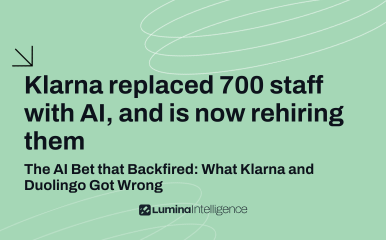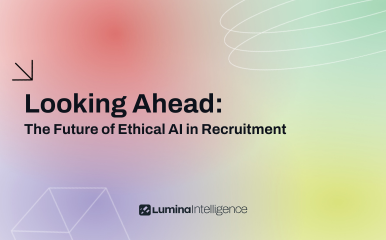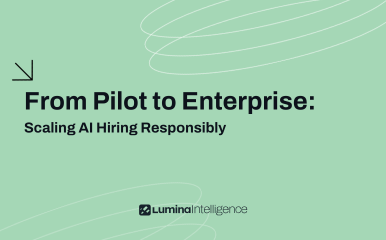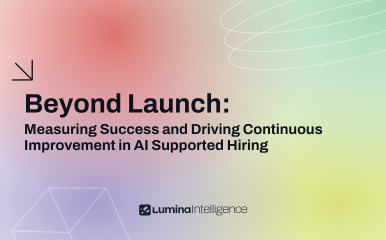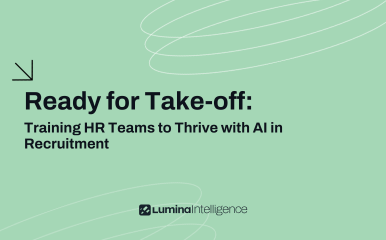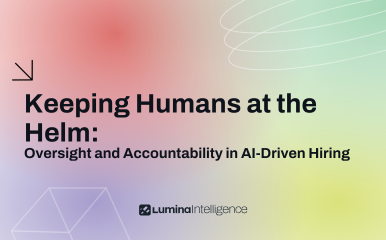To Recap…
In Weeks 1 and 2, we explored the fundamental importance of ethical AI in recruitment and delved into the regulations shaping how this technology can be used responsibly. Despite the significant benefits AI provides—such as efficiency and scalability—it can also perpetuate or even amplify bias if not carefully managed.
In this week’s article, we’ll examine how biases creep into AI-driven hiring processes, why fairness matters so much for your employer brand and compliance, and the steps you can take to ensure your technology is genuinely serving the interests of both the organisation and its candidates.
Why AI-Driven Hiring Can Be Prone to Bias
AI systems learn from datasets that reflect real-world outcomes, which are often riddled with historical inequalities. If your training data disproportionately represents a particular gender, ethnicity, or educational background, the model can inadvertently replicate these imbalances. Factors that typically introduce bias include:
- Historical Data: If a company’s past hiring practices favoured one demographic over another, the AI might assume that is the benchmark for success.
- Imbalanced Sample Sizes: AI often struggles with small data sets. If minority groups are underrepresented, the model’s performance in assessing those groups may be less accurate.
- Proxy Variables: Even if the AI does not use characteristics like gender or race directly, it may rely on correlated factors (e.g., certain hobbies, locations, or even styles of CV writing) that lead to unintended discrimination.
The Importance of Fairness
Bias in recruitment undermines one of HR’s core objectives: placing the best candidate in the right role. Beyond the ethical imperative, unchecked bias can invite legal complications (as discussed in Week 2) and tarnish your employer brand. A fair, objective, and open recruitment process:
- Expands Talent Pools: When groups aren’t systematically disadvantaged, you can attract and retain a more diverse set of applicants—a known driver of innovation and performance.
- Builds Trust: Candidates increasingly expect transparency in how companies evaluate job applications. Fair hiring processes help cultivate goodwill and a positive reputation.
- Upholds Compliance: Anti-discrimination laws, such as the Equality Act 2010 in the UK, penalise biased practices. By prioritising fairness, you reduce your legal and reputational risks.
Common Types of Bias in AI Hiring
- Data Bias
- Unrepresentative Datasets: If historical data skews toward certain demographics, the AI replicates these trends.
- Quality of Data: Incomplete or erroneous candidate data can mislead the algorithm.
- Algorithmic Bias
- Model Drift: Over time, algorithms might shift their decision boundaries as the job market and candidates change.
- Weighting and Feature Selection: If certain features strongly correlate with protected characteristics (e.g., postcode), the model’s predictions may inadvertently sideline certain groups.
- Human Bias in Parameters
- Subjective Criteria: HR professionals might unintentionally introduce bias when defining “success profiles” or setting cut-off thresholds in the AI system.
- Lack of Explainability: A “black box” approach makes it difficult for recruiters to spot or correct algorithmic anomalies.
Practical Strategies to Mitigate Bias
- Diverse and Balanced Training Data
- Data Augmentation: If certain demographics are underrepresented, consider synthetic data generation or targeted recruitment campaigns to ensure more balanced input.
- Continuous Data Updates: Regularly refresh and expand your training dataset with new, quality data from multiple sources.
- Regular Bias Audits
- Quantitative Checks: Compare outcomes for different demographic groups at various steps in the hiring funnel to spot disparities early.
- Ethics Committee or Internal Working Group: A designated body can review AI decisions, investigate anomalies, and recommend improvements.
- Algorithmic Transparency and Explainability
- Explainable AI Tools: Use frameworks or software that help you understand which variables are most influential in your hiring decisions.
- Candidate Communication: Provide clear feedback channels so candidates can query or appeal decisions, promoting trust in the system.
- Human Oversight
- Human-in-the-Loop: Recruiters should review AI-generated shortlists and have the authority to override decisions they believe are unjust or inaccurate.
- Expert Collaboration: Involve data scientists, diversity officers, and HR specialists in reviewing metrics and adjusting model settings.
- Inclusive Design and Testing
- Pilot Testing with Diverse Groups: Before rolling out AI organisation-wide, conduct small-scale tests with diverse employee or candidate groups to gather feedback and pinpoint hidden biases.
- Iterative Refinement: Treat your AI system as an evolving tool that must be fine-tuned over time, rather than a “set-and-forget” solution.
Case Example: Overcoming Bias in Automated CV Screening
Imagine a tech start-up that historically hired more from top-tier universities due to the personal networks of its founders. By feeding these historical hiring patterns into an AI, the model consistently ranked candidates from specific universities higher—unintentionally disadvantaging those from less “prestigious” institutions.
- Mitigation:
- The company diversified its training data to include examples of high-performing employees from various educational backgrounds.
- They conducted regular audits, comparing the success rates of applicants from different universities.
- Human oversight allowed recruiters to question AI decisions and invite second-round screenings for any “borderline” candidates.
As a result, the pool of new hires broadened, and the company reported improved innovation and team collaboration due to a more diverse workforce.
Building Fairness into Your Organisational Culture
While technical measures are crucial, the larger culture in which AI is deployed also matters. Championing fairness and inclusivity—from the C-suite down—sets the tone for how diligently teams will monitor and address bias.
- Leadership Support: Leaders should visibly endorse practices that foster equality and inclusivity.
- Employee Training: Regular workshops on diversity, AI basics, and unconscious bias can help staff spot and address concerns in real time.
- Open Feedback Loops: Encourage team members to question AI-driven outcomes without fear of retribution, fostering a learning environment that enhances fairness.
Conclusion: Making AI Work for Everyone
Bias is an all-too-common pitfall in AI-driven hiring, but it doesn’t have to be a permanent fixture. By auditing data sources, integrating transparency tools, and ensuring robust human oversight, organisations can build recruitment processes that benefit from AI’s speed while preserving fairness and inclusivity.
At Lumina Intelligence, we’ve embedded bias mitigation strategies into our platform, allowing businesses to harness AI’s advantages without sidelining ethical obligations. If you commit to a cycle of review, feedback, and iteration, AI can truly serve as an equaliser rather than a barrier.
What’s Next?
Stay tuned for Week 4, where we’ll tackle Privacy and Data Protection in AI hiring. We’ll explore how to safeguard candidate information, stay compliant with regulations like the UK GDPR, and maintain the trust of applicants throughout the entire hiring journey.
